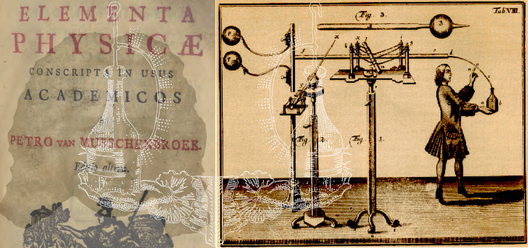Pieter van Musschenbroek1692–1761
Neuroscience was transformed by electricity but the current coursed slowly from its attractive source, magnetism. William Gilbert (1544-1603) carried out some of the first systematic studies of the lodestone and distinguished its properties from those of producing the attractive effect by friction with amber. In so doing he introduced the term that was to become electricity. Gilbert was a physician although his concerns with electricity and magnetism were directed towards cosmology rather than medicine. The investigation of electricity was transformed by the invention of the capacitor in 1745 by Musschenbroek, together with his collaborators Andreas Cunaeus (1712-1788), and Jean-Nicolas-Sébastien Allamand (1713-1787). Musschenbroek was then professor of physics in Leiden – hence its name. Musschenbroek is shown on the left combined with the title page of his influential book, Elementa Physicae, as well as the ghostly presence of the Leyden jar; this is repeated in the illustration on the right (which is one of Musschenbroek’s illustrations). Prior to the Leyden jar, electricity was produced by a variety of friction machines, but the discharge produced by these devices was relatively mild because of the small charge involved. The importance of the Leyden charge (and of other subsequent capacitors) was in the great charge that could be accumulated because of the capacitance effect of two electric conductors situated in near proximity.
